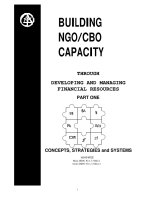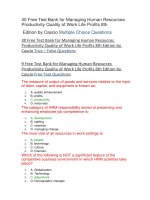Lecture Business management information system - Lecture 16: Managing information resources
Bạn đang xem bản rút gọn của tài liệu. Xem và tải ngay bản đầy đủ của tài liệu tại đây (820.55 KB, 48 trang )
Managing Information
Resources
Lecture 16
Managing Information Resources
n
Managing Information Resources Lectures explores the
management of data information, and knowledge
n
It begins by identifying some problems in managing data,
and then surveys the evolution of database management
systems, including the next-generation systems
n
It explores the various types of information that
companies need to manage as they treat information as
an organizational resource
Managing Information
Resources
n
It concludes by discussing one of the most important
issues facing companies today: how to manage
knowledge
n
Case examples include Monsanto, Owens & Minor,
HICSS Personal Proceedings, Tapiola Insurance Group,
Tennessee Valley Authority, Eastman Chemical
Company and Groove Networks
Today’s Lecture
n
n
Introduction
Managing Data
¨ The
Three-Level Database Model
¨ Four
Data Models
¨ Getting
Corporate Data into Shape
Today’s Lecture..
n
Managing Information
¨ Four
Types of Information
¨ Data
Warehouses
¨ Document
¨ Content
Management
Management
Introduction
n
“Managing information resources” initially meant
managing data, first in files, then in corporate databases
which were:
¨ Well
structured
¨ Carefully
defined, and
¨ Controlled
by IS department
Introduction
n
Data vs. Information vs. Knowledge
¨ Data:
n
facts devoid of meaning or intent
¨ Information:
data in context
¨ Knowledge:
information with direction or intent
As the breadth of the kinds of information resources has
expanded, so has the job of managing them. The job
may not start in the IS department but it invariably ends
up there
Introduction
¨ PCs
users used ‘alone’
n
Needed to share files
n
Version control, back-up etc.
¨ Web
sites / content
Introduction
n
Initially created their own
n
Need for recovery, version control
n
Corporate consistency
¨ IS
to the ‘rescue’
n
Management procedures
n
Discipline
Introduction ..
n
Corporate databases are still a major IS department
responsibility
¨ Sometimes
housed in a variety of database models
¨ Production
databases – transaction
¨ Data
warehouses
¨ CRM
–Customer Relationship Management
Introduction
n
Information in the form of documents (electronic or
paper) and Web content has exploded the size of
databases organizations now manage
n
Knowledge management is becoming a key to exploiting
“intellectual assets”
n
Information resources need to be well managed as
information becomes an important strategic resource
Managing Data
n
Database management systems are the main tool for
managing computerized corporate data
n
They have been around since the 1960s and are based
on two major principles:
¨ A three- level conceptual model and
¨ Several alternative ‘data models’ for organizing the
data
DBMS EXAMPLE
Managing Data:
The Three-Level Database Model
n
Level 1 – The external, conceptual, or local level,
containing the various “user views” of the corporate data
that each application program uses
¨ Not
concerned with how the data will be physically
stored or what data is used by other applications
Managing Data:
The Three-Level Database Model
n
Level 2 - The logical or “enterprise data” level
¨ ‘Technical’ (human)
control of the DBAs
n
view of the database = under
Level 3 - The physical or storage level, specifying the
way the data is physically stored
¨ End
user not concerned with all these ‘pointers and
flags’ (how the data is physically organized) = they
are for use by the DBMS
The Three-Level Database Model:
Advantages
n
Level 2 absorbs changes made at Level 3 such
as using a new physical storage device
¨ Individual
application programs in Level 1 do not need
to be changed when the physical layer changes
n
Data only needs to be stored once in Level 2,
and different programs can draw on it and vary
the relationships among the data
Managing Data:
Four Data Models
The second major concept in database management is
alternate ways to define relationships among data
Hierarchical model: structures data so that each
element is subordinate to another in a strict
hierarchical manner
1.
‒
Parent, child etc.
Network model: allows each data item to have more
than one parent,
2.
‒
Relationships stated by pointers stored with the data
Managing Data:
Four Data Models cont.
3.
Relational model:
where the data is stored in tables.
–
Eight relational operations can be performed on this
data
Select, Project, Join, Product, Intersection,
Difference, Union, Division
4.
Entity-Relationship model:
Managing Data:
Four Data Models cont.
n
¨
Microsoft Access
Relational systems are not as efficient as hierarchical or
network database systems, but because relational systems
allow people to create relationships among data on the fly.
More flexible
Microsoft Access DBMS Example
Managing Data:
Four Data Models cont.
n
First used to handle end user queries – they are now
widely used in high-volume transaction systems with
huge files
n
Hence, they have become the database technology of
choice in today’s systems
¨
Also = largely due to decrease in costs of
technology: processing and disk storage
Managing Data:
Four Data Models cont.
Object model: can be used to store any type of data, whether a:
4.
–
Traditional name or address,
–
An entire spreadsheet,
–
A video clip,
–
A voice annotation,
–
A photograph, or
–
A segment of music
Managing Data:
Four Data Models cont.
The tenets of objects have become increasingly
important in the world of computing
n
–
E.g. Web Services because the XML modules utilize
object principles
Managing Data:
Four Data Models cont.
Typical, yet complex database applications that may
require objects:
n
–
CAD for a large office building
–
Large retail chains record every product code
scanned
–
Insurance policy files e.g. claim forms, images,
video etc.






